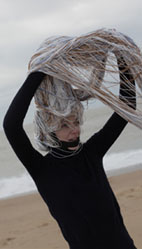Alexandra Bertaut
Costume Designer
Birthplace: Paris, France
Alexandra Bertaut was born 1973 in Paris and livet and works in Paris and other places. She in an explorer who sees the body as a subject, not a pretext. Alexandra Bertaut works with defining and shaping spaces and relations between for example identity – individuality, multifaceted – social being. She started out with studies in art, fashion and design and has since continued her research with Carlotta och Caterina Sagna, Edmond Russo och Shlomi Tuizer, Frank Micheletti, Fabrice Lambert, Maud Le Pladec, Herman Diephuis, Thomas Quillardet, Richard Siegal, Su-feh Lee and Benoît Lachambre.
Interview with Alexandra Bertaut
• What inspires you?
Everything! Spaces around… History and stories through… Everything… I only have to open my eyes, my ears, my mind and body (smile). Everything acts on my explorations… I look upon my work as a “living” research, near an anthropological exploration.
• How did you get the idea for the träskor?
It’s a combination of several things. At the beginning of the project with Cullberg Ballet, Benoît (choreographer) just said to me that he would like to work with high heels, very (very) high heeled shoes. A work around the balance and what this balance generates in/on the body. It’s very interesting to investigate this object of desire. I developed some work-platforms made in wood to begin the research. Some wooden shoes roughly strapped in feet, similar to torture artefacts. What high heels are in a way. That refers to all the pictures of this “feminin” torture and its intricate and strange beauty as well. Like points to dance… I had to find a name, a new appellation to name this singular collection… playing with words and meanings… and also the place where they were “born”… “Träskor” in Swedish means “clogs”, “wooden shoes” like “hooves”… or shoes with wooden soles… And I love the sound that makes also… “t r ä s k o r”… It was perfect.
• What does the hair-gear express?
In French it would be “parures de cheveux” – translated as “hair-gear”. In the same way it’s a research on “feminin attributes”: long hair. Like a seduction object and a beautiful and an hypnotic impediment as well. Some “wigs” but also a “dress”, a “skirt”, and a “mask” are made of “hair”, the same fabric as the installation. Like fineries, the “hair” make up a kind of new set or “gear” of outfits. An inherent finery, like an extension of the body, that, inevitably, generate its own motions.
• What was the inspiration for the full body suits?
Gender exploration. Individution. And living organisms… All my work is a research on the relationships between the body and outfits – costumes as well. The cultural implications of the costumes. How outfits act on the body , generate movements, influence movement. And contribute to the perception of the body as well. From the full-body costume wearers to the viewers. Inside and outside feelings. Limits perceptions… I could also tell you a story about Quetzal, a beautiful bird with magnificent colors on feathers…
• In what way do the set design, the music, the lights and the costume collaborate in High heels too?
All these elements make up a whole. Like an interaction between all of them.
• What has been special working with Cullberg Ballet?
More than special! It was just great to research with the Cullberg Ballet! The performers are so great!
• What is your dream project for the future?
Live in the present…beyond my wildest dreams! (smile)


